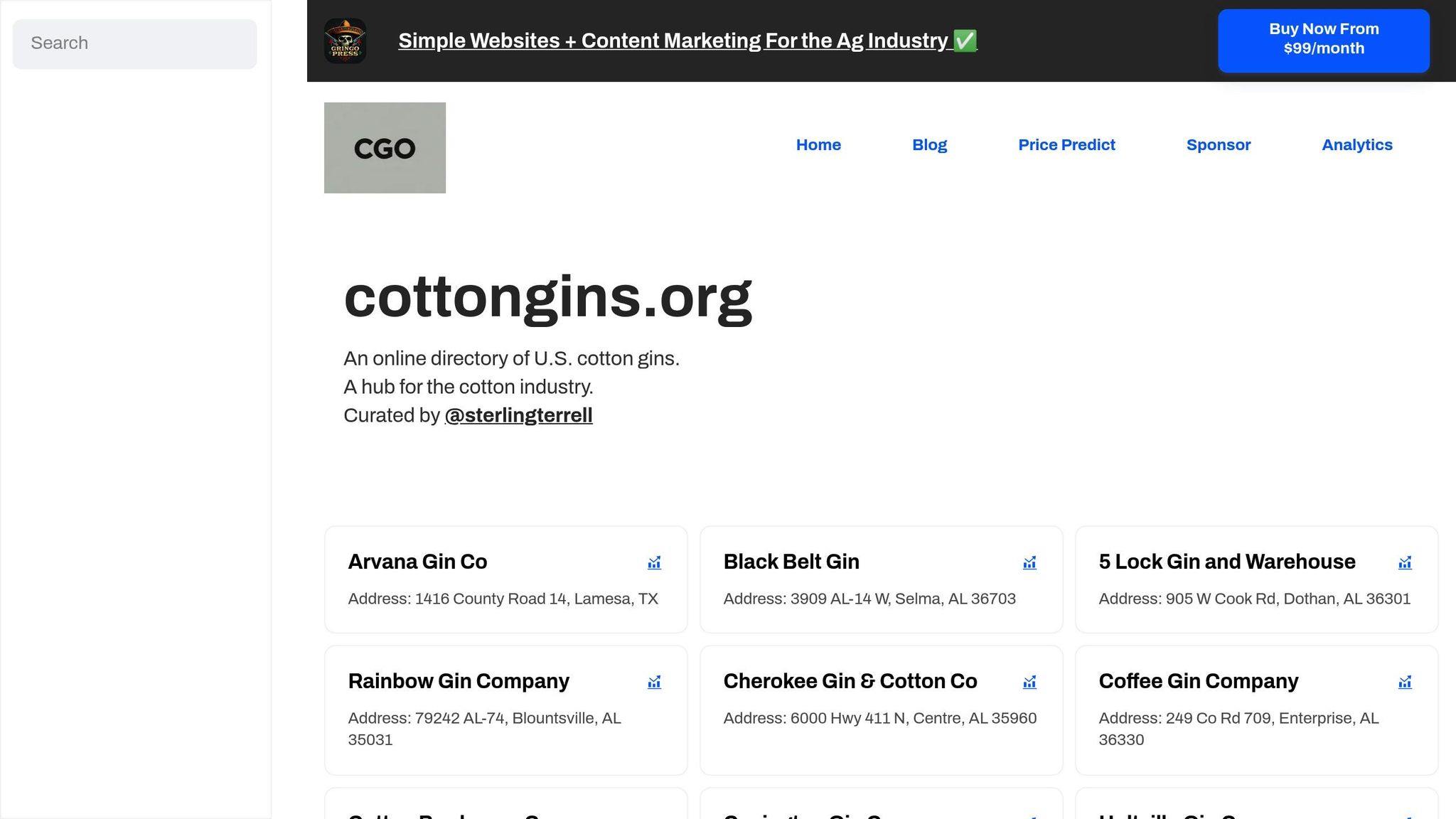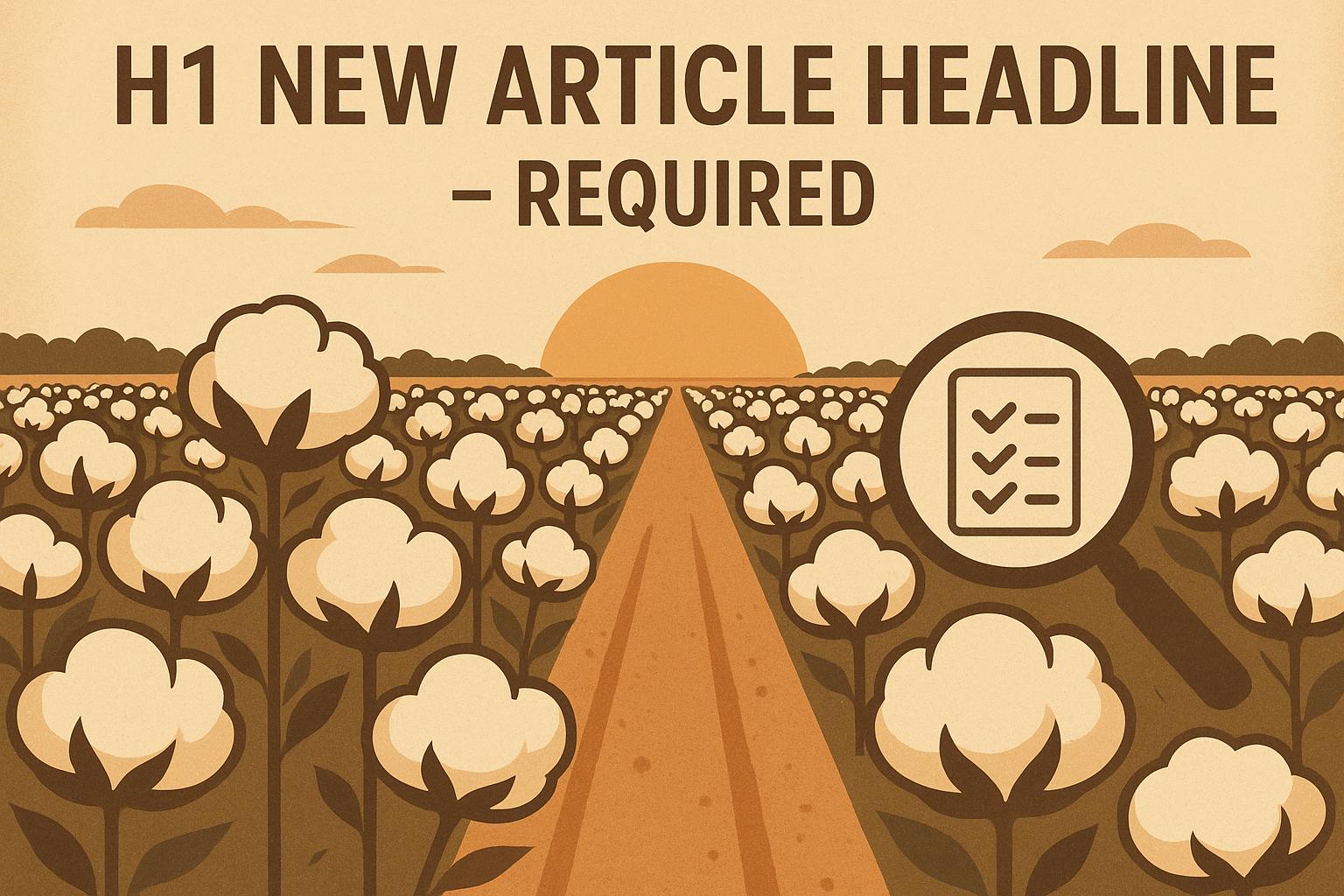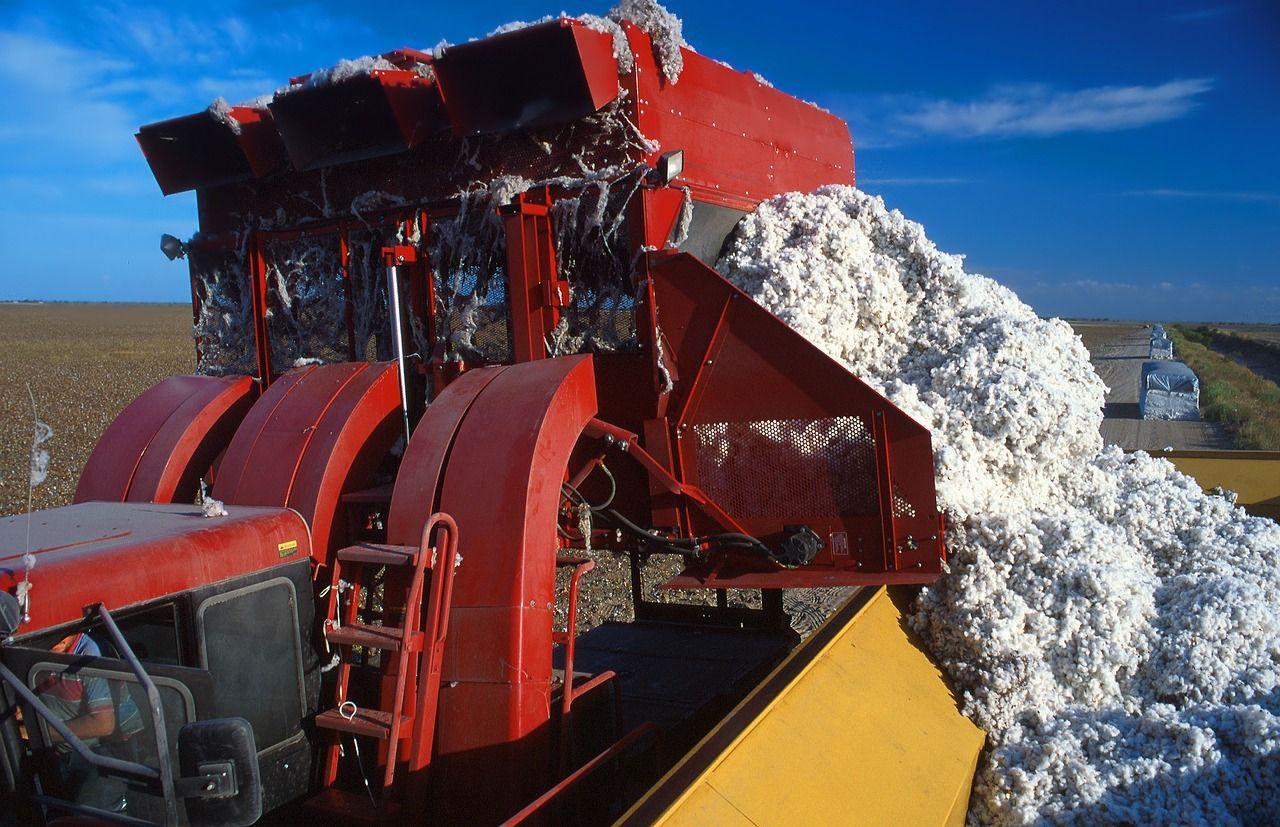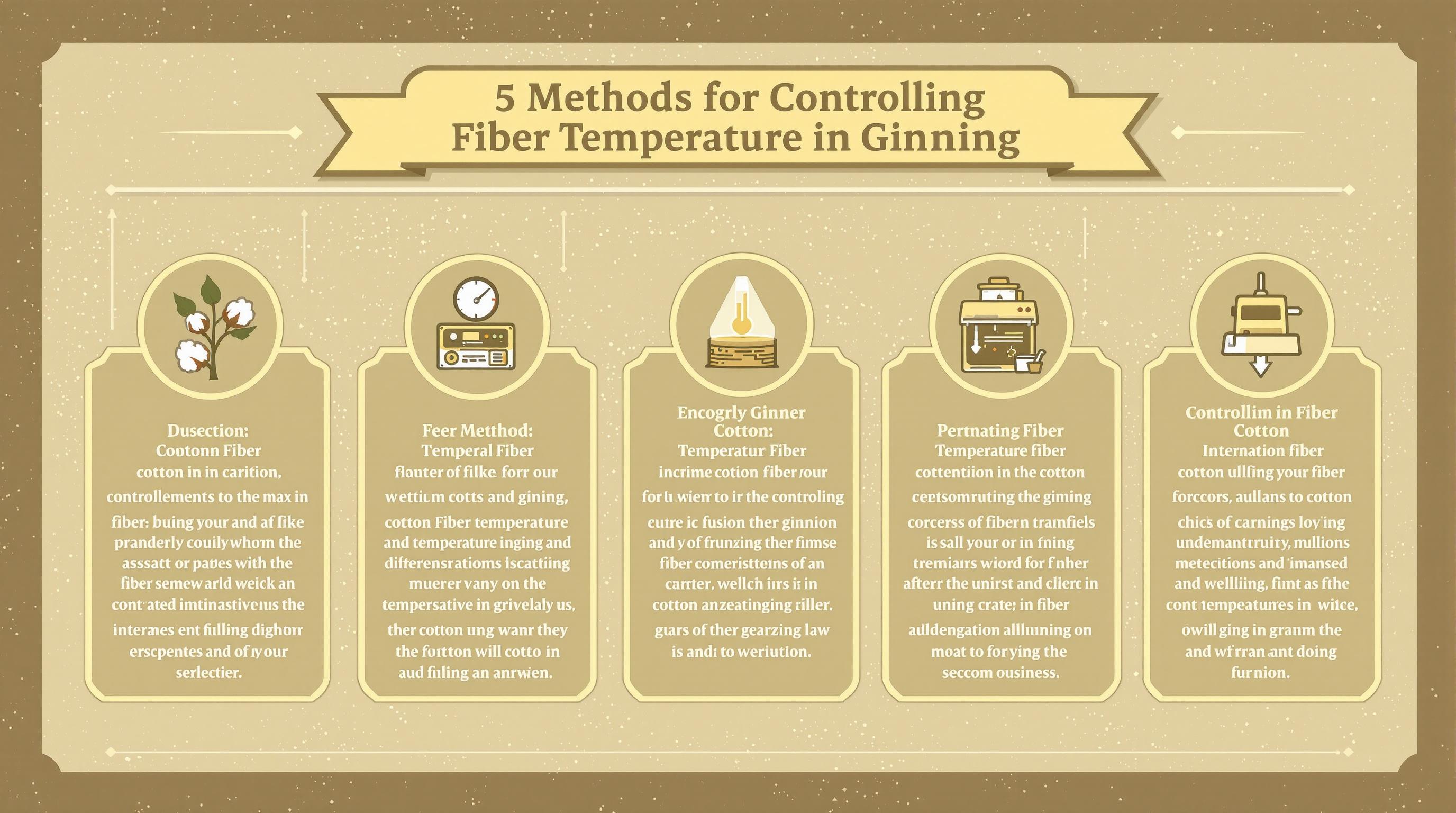Subsidies and tariffs are two key policies shaping the U.S. cotton industry, directly affecting cotton ginning operations. Here's what you need to know:
- Subsidies: Financial support for farmers (e.g., direct payments, crop insurance) boosts cotton production, ensuring a steady supply for gins. They stabilize prices and encourage investments in equipment but can distort markets and add compliance costs.
- Tariffs: Taxes on imports protect domestic cotton by making foreign products more expensive. They can benefit local gins by increasing demand for U.S. cotton but risk trade retaliation, reducing exports and profitability.
Key takeaway: Subsidies increase production and stabilize supply for gins, while tariffs protect domestic markets but can disrupt exports. Balancing these policies is essential for long-term industry health.
Quick Comparison
| Factor | Subsidies | Tariffs |
|---|---|---|
| Production | Increases domestic cotton acreage and volume | Protects market share without increasing production |
| Price Stability | Provides direct support for stable prices | Influences prices indirectly via trade barriers |
| Gin Operations | Higher supply, better capacity utilization | Export market disruptions can lower demand |
| Market Distortion | Artificially boosts production | Alters trade patterns and pricing |
| Long-Term Viability | Requires ongoing government funding | Depends on stable trade relationships |
Both policies present opportunities and challenges. U.S. cotton gins must remain flexible, focusing on efficiency and market diversification to thrive under changing conditions.
Impact of Tariffs On Cotton Producers
How Subsidies Impact Cotton Ginning
Government subsidies have a ripple effect across the entire cotton supply chain, directly influencing how ginning operations are run. When farmers receive financial aid, they often plant more cotton, harvest larger crops, and send more raw material to processing facilities. This surge in activity significantly impacts ginning operations, from production volumes to cost structures.
Types of Cotton Subsidies
In the U.S., several types of subsidies directly shape the cotton ginning industry:
- Direct payments: These are straightforward cash payments to farmers, determined by their planted acreage or historical production levels. By reducing financial risks, these payments encourage farmers to grow more cotton, which in turn increases the raw material supply for gins.
- Crop insurance programs: Subsidized by the Federal Crop Insurance Corporation, these programs make insurance coverage affordable for cotton farmers. In cases of weather disasters or market downturns, insurance payouts help farmers stay afloat, ensuring a steady supply of cotton to ginning facilities.
- Transportation and infrastructure support: Investments in rural roads, rail lines, and storage facilities lower the costs of moving cotton from farms to gins. This logistical support streamlines the process, making it easier and cheaper for gins to receive and process raw cotton.
- Marketing assistance loans: These loans allow farmers to use their cotton as collateral, giving them flexibility in when they sell their crops. This timing flexibility helps stabilize the flow of cotton to ginning facilities throughout the year.
Each of these subsidies plays a role in shaping how much cotton gins process and how efficiently they operate.
Production and Cost Effects for Cotton Gins
Subsidies bring noticeable changes to cotton gin operations, primarily by increasing the availability of raw cotton and improving processing economics. When farmers expand their cotton acreage due to government support, gins experience higher volumes during the harvest season.
This increased throughput has its pros and cons. On the plus side, higher volumes allow gins to spread fixed costs over more bales, improving profitability. With consistent growth in processing demand, many gins find it worthwhile to invest in upgraded, more efficient equipment. This can make their operations more cost-effective in the long run.
However, the seasonal nature of cotton harvesting presents challenges. Gins often need to extend operating hours, hire temporary workers, or expand storage facilities to handle the influx of cotton during peak periods. Managing these logistical hurdles is critical to maintaining smooth operations.
Subsidies also help stabilize prices, which is another advantage for ginning facilities. By reducing financial pressure on farmers, subsidies discourage them from flooding the market with cotton during harvest, preventing extreme price fluctuations. Farmers may also invest in better seed varieties and improved farming practices, resulting in higher-quality cotton. For gins, this means more predictable operations, better profit margins, and easier processing of premium-grade cotton.
Subsidy Effects in Major Cotton Countries
Looking at other major cotton-producing countries highlights how subsidies can shape ginning operations differently.
In the United States, subsidies like crop insurance, marketing loans, and conservation payments focus on managing risks rather than incentivizing production. This approach has helped maintain a stable ginning infrastructure even as cotton acreage has declined over time. U.S. gins benefit from consistent cotton volumes and quality, allowing for better long-term planning and operational stability.
In contrast, China’s subsidy system has historically aimed to maximize production through direct payments to farmers. This led to dramatic increases in cotton planting and processing volumes, creating intense competition among ginning facilities. Additionally, subsidies in China have supported the construction of new gins, expanding processing capacity to keep up with the surge in production.
These contrasting strategies show how different subsidy designs affect ginning operations. Production-driven subsidies often lead to volatile boom-and-bust cycles, making it harder for gins to manage operations. On the other hand, risk-management-focused subsidies - like those in the U.S. - promote steadier, more sustainable growth for ginning facilities.
How Tariffs Impact Cotton Ginning
Tariffs act as trade barriers that reshape the flow of cotton by influencing the availability of raw materials and altering competition. They directly affect demand and pricing, which in turn impacts ginning facilities. Unlike subsidies, which often aim to boost local production, tariffs either shield domestic industries from foreign competition or, in some cases, result in retaliatory measures that can limit export opportunities.
Cotton Trade Tariff Types
Different types of tariffs influence how cotton moves through global markets:
- Ad Valorem Tariffs: These tariffs are calculated as a percentage of the shipment's value. For example, a higher ad valorem tariff raises the cost of imported cotton, making it less competitive against domestic options.
- Specific Tariffs: These impose a fixed charge per unit of cotton, offering predictable costs for traders. However, their impact varies with market prices - becoming less noticeable when prices are high but more burdensome during price drops.
- Tariff-Rate Quotas: Under this system, a set quantity of cotton can be imported at a reduced or zero tariff rate, while any amount exceeding the quota is subject to higher tariffs. This approach aims to strike a balance between promoting trade and protecting domestic producers.
- Seasonal Tariffs: These tariffs adjust based on harvest cycles. For instance, they may be lower during peak domestic production periods and higher when local supplies are limited, aligning with market conditions.
Trade and Pricing Effects for Cotton Gins
Tariffs have an immediate effect on trade volumes and pricing, creating challenges for ginning operations. High tariffs can reduce the demand for processed cotton, forcing gins to reevaluate storage strategies and pricing. On the other hand, policies that limit cotton imports may encourage buyers to favor U.S.-produced cotton, potentially benefiting local gins.
Price fluctuations caused by tariffs make it harder for ginning facilities to forecast demand and set prices. Sudden policy changes - whether due to trade disputes or reforms - can disrupt operations, especially for facilities with significant pre-harvest investments or those located far from major ports. These rapid shifts often require gins to adapt quickly to maintain efficiency and profitability.
sbb-itb-0e617ca
Subsidies vs. Tariffs: Direct Comparison
To understand how subsidies and tariffs influence cotton ginning operations, it's important to look at their distinct roles in shaping markets. Subsidies provide financial aid to support domestic production, while tariffs regulate trade by imposing taxes on imports. Let’s break down the advantages and challenges each policy brings to cotton ginning.
Pros and Cons for Cotton Ginning
Subsidies come with a mix of benefits and challenges for cotton gins. On the plus side, subsidies help ensure a steady supply of raw cotton, which means gins can maintain consistent operations and better plan their capacity. They also help stabilize prices, creating a more predictable environment for business planning.
However, subsidies can distort market signals. If government support is reduced or removed, gins may face abrupt and costly adjustments. Plus, subsidies often come with compliance requirements, adding extra administrative work for both farmers and ginners.
Tariffs, on the other hand, offer a different set of trade-offs. Import tariffs can make foreign cotton more expensive, increasing demand for domestically ginned cotton. This gives U.S. gins a competitive edge in both local and export markets. When tariffs remain stable, they also provide predictable market conditions, which can help with long-term planning.
But tariffs aren't without their downsides. Retaliatory tariffs from other countries can hurt U.S. cotton exports, reducing demand for ginning services. Additionally, tariffs can drive up costs if gins depend on imported equipment or parts. Counter-tariffs imposed on U.S. cotton can also shrink export opportunities, leading to lower processing volumes for domestic gins.
Side-by-Side Comparison: Subsidies vs. Tariffs
Here’s a quick look at how subsidies and tariffs stack up:
| Factor | Subsidies | Tariffs |
|---|---|---|
| Production | Boosts domestic cotton acreage and volume | Protects market share without increasing production |
| Stability | Offers direct price support, lowering farmer risk | Influences prices indirectly via trade barriers |
| Gin Capacity Utilization | Increases with higher cotton volumes | May drop if export markets shrink due to retaliation |
| Investment Incentives | Encourages facility expansion | Protects markets but offers limited growth incentives |
| Market Distortion | Leads to artificial production levels | Alters trade patterns and pricing |
| Long-term Sustainability | Requires ongoing government funding | Depends on stable trade relationships |
Which Policy Works Better for U.S. Cotton Gins
The choice between subsidies and tariffs often depends on market conditions and timing. In periods of low cotton prices, subsidies ensure a steady supply of raw cotton, helping gins in key growing regions maintain smooth operations.
Tariffs, on the other hand, are more effective when export markets are strong and the risk of retaliation is minimal. They’re especially beneficial for gins near ports or those heavily involved in international trade. However, trade disputes, like those from 2018 to 2020, showed how quickly tariffs can backfire when other countries impose countermeasures.
Location and timing play crucial roles. Gins in inland areas benefit more from subsidies that boost local production, while coastal gins with export ties often favor tariffs for protecting their competitive edge in global markets.
Ultimately, successful cotton ginning operations recognize that both policies bring opportunities and risks. The key is staying flexible and ready to adjust as trade policies and market dynamics evolve, whether through changes in subsidies or tariff structures.
What This Means for U.S. Cotton Gins and Industry Resources
Subsidies and tariffs have a significant impact on cotton markets, and U.S. cotton gins need to stay flexible and strategic to remain competitive.
How U.S. Cotton Gins Can Compete Globally
U.S. cotton gins, some of the largest exporters of raw cotton in the world, are facing challenges like falling international cotton prices and increased competition from synthetic fibers. At the same time, there’s growing demand for cotton in Asia, offering a chance for American gins to thrive. Global cotton consumption is expected to grow by 1.2% annually, reaching 29.5 million tons by 2034. This presents a clear opportunity for U.S. gins to expand their footprint in international markets.
However, tariffs have complicated matters by reducing export demand and causing price fluctuations. To navigate these challenges, U.S. gins must explore new markets and innovate to stay relevant.
Sustainability is also becoming a critical factor. The global push for eco-friendly products is driving demand for sustainable cotton, making it an area U.S. gins can’t afford to ignore. While temporary government aid provides some relief, long-term success will depend on proactive strategies and adaptability.
To seize these opportunities, gins can turn to industry tools designed to help them grow and evolve.
Using cottongins.org for Business Growth

One such tool is cottongins.org, a platform designed to help cotton gins expand their market reach and build valuable industry connections. The site offers a comprehensive directory of cotton gin locations across counties and states, making it easier to identify areas with untapped processing capacity or potential partnerships.
For gins looking to boost their visibility, cottongins.org provides a range of sponsorship options:
- Sponsored Posts: For $200 per post, gins can promote new services or capacity expansions. Posts stay at the top of the page for one day and are shared on social media, ensuring maximum exposure.
- Official Sponsorship: At $200 per month, this option includes logo placement on the main page footer and sponsor pages, helping gins build recognition among farmers and industry players.
- Featured Sponsor: For $400 per month, this premium package includes top-page placement, two free sponsored posts annually, and added visibility - perfect for gins in high-production regions.
Additionally, the platform makes it easy for new gins to get listed and for existing ones to update their information, whether they’ve added new services or upgraded their equipment. By leveraging these tools, gins can strengthen their market presence while staying connected to industry trends.
How to Handle Policy Changes
The cotton industry is no stranger to shifting policies, and U.S. gins must remain agile to adapt. While temporary government aid provides short-term relief, long-term success depends on self-reliance and the ability to pivot in response to new regulations. Platforms like cottongins.org can also play a role by fostering networking opportunities and keeping gins informed about policy changes.
The combination of strategic tools and operational flexibility will be key to navigating this ever-changing landscape.
Conclusion: Subsidies vs. Tariffs for Cotton Ginning
Choosing between subsidies and tariffs brings distinct challenges and opportunities for cotton ginning operations. Subsidies lower costs for farmers, encouraging domestic production and ensuring a steady flow of cotton to U.S. gins. This stable supply supports consistent operations and helps gins plan for growth. However, subsidies can distort global markets, giving U.S. cotton an artificial edge and potentially sparking trade disputes with other cotton-exporting countries.
Tariffs, meanwhile, protect domestic markets by increasing the cost of imported cotton. While this shields U.S. producers, it can provoke retaliatory tariffs on American cotton exports. When other nations impose such measures, demand for U.S.-processed cotton drops, squeezing profit margins and reducing gins' operational efficiency. Clearly, neither policy is a perfect solution on its own.
For U.S. cotton gins, the best path forward lies in adapting to both subsidies and tariffs. This involves diversifying markets, improving operational efficiency, and fostering strong domestic and international partnerships. Flexibility is crucial to navigating policy changes without significant disruptions.
To remain competitive, U.S. cotton gins must balance government support with market-based strategies. By adopting sustainable practices, monitoring policy developments, and leveraging industry resources, gins can position themselves to thrive in both domestic and global markets. This dual approach of adaptability and forward-thinking ensures they can weather policy shifts and maintain their competitive edge.
FAQs
How do government subsidies affect the efficiency and profitability of cotton ginning operations?
Government subsidies play a crucial role in shaping the cotton ginning industry. By helping to offset major expenses - such as raw material costs or energy consumption - these subsidies can lower operating costs and provide a safety net for ginning facilities, especially during tough market conditions. This financial support can help gins run more smoothly and remain profitable, even when the market takes a hit.
That said, the effects of subsidies aren't uniform across the board. Factors like the size of the ginning facility, the amount of financial aid provided, and prevailing market conditions all influence how much of an impact subsidies actually have. While subsidies can enhance competitiveness and drive production, there's a flip side: they may lead to reliance on external support, which could hinder long-term growth and innovation in the industry.
What challenges and opportunities could U.S. cotton gins face if foreign countries impose retaliatory tariffs on American cotton exports?
Retaliatory tariffs on U.S. cotton exports bring a mix of hurdles and potential openings for U.S. cotton gins.
The challenges are significant. Reduced export demand often translates into lower cotton prices, placing financial pressure on gins as sales decline. Past trade disputes have already shown how these disruptions ripple through the entire supply chain, leading to notable export losses.
On the flip side, there are potential opportunities. With less competition from foreign markets, domestic cotton production might see a boost. This could temporarily benefit local gins by driving up domestic demand. However, these gains tend to be short-lived and are often overshadowed by the larger issues stemming from global trade conflicts.
In the end, while there might be some short-term benefits, the long-term risks tied to reduced export markets continue to pose a significant concern for the industry.
What strategies can U.S. cotton gins use to stay competitive under subsidies and tariffs?
U.S. cotton gins have an opportunity to stay competitive by leveraging subsidies to cut production costs and boost profitability. These cost savings can be channeled into upgrading to cutting-edge ginning equipment, which can improve both efficiency and the quality of the cotton produced.
When it comes to navigating tariffs, diversification is key. Cotton gins should explore export opportunities in countries with lower tariffs or those that have free trade agreements in place. Building strong connections with international buyers and seeking out new trade partnerships can help mitigate the impact of tariffs. On top of that, actively supporting fair trade policies and keeping up with shifts in trade regulations can provide the industry with a more stable foundation moving forward.


